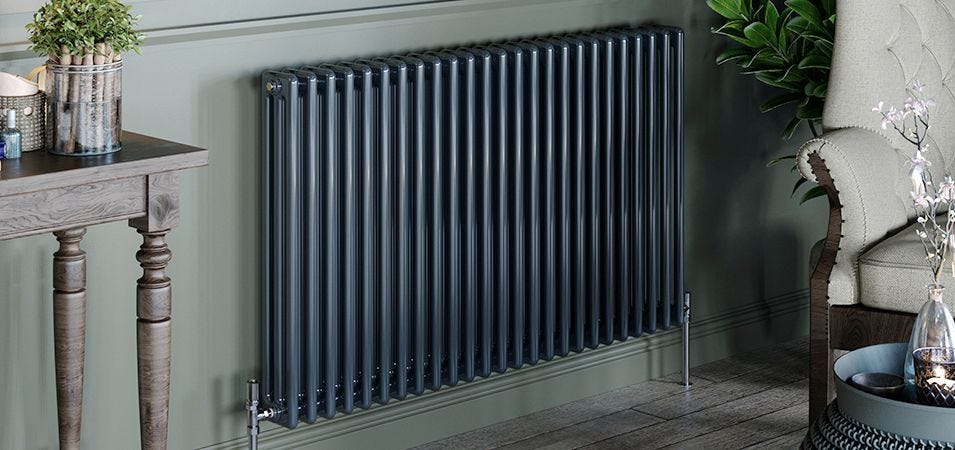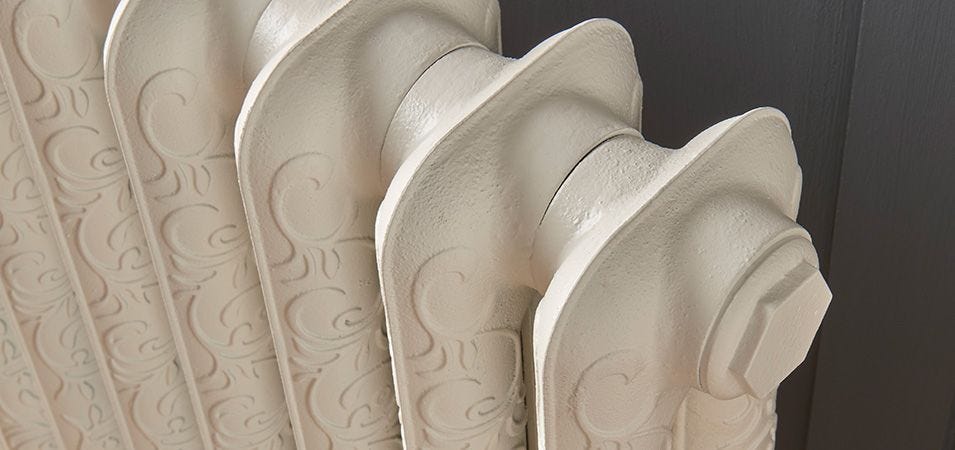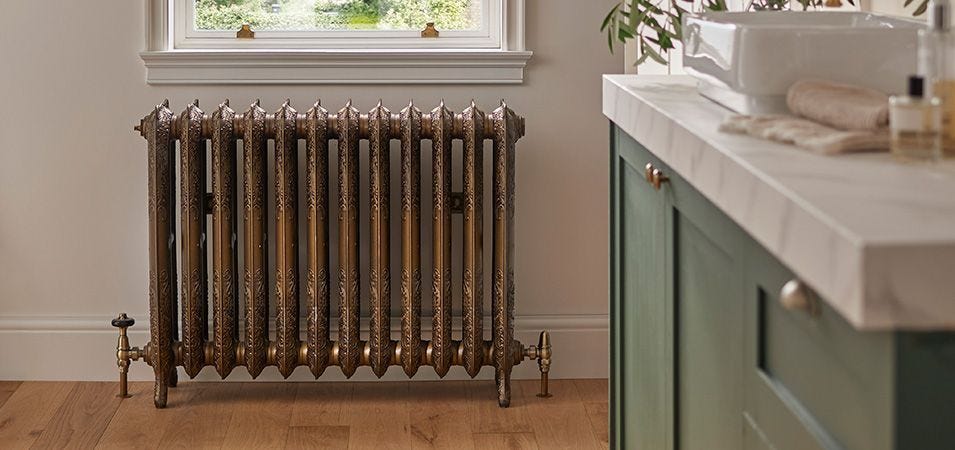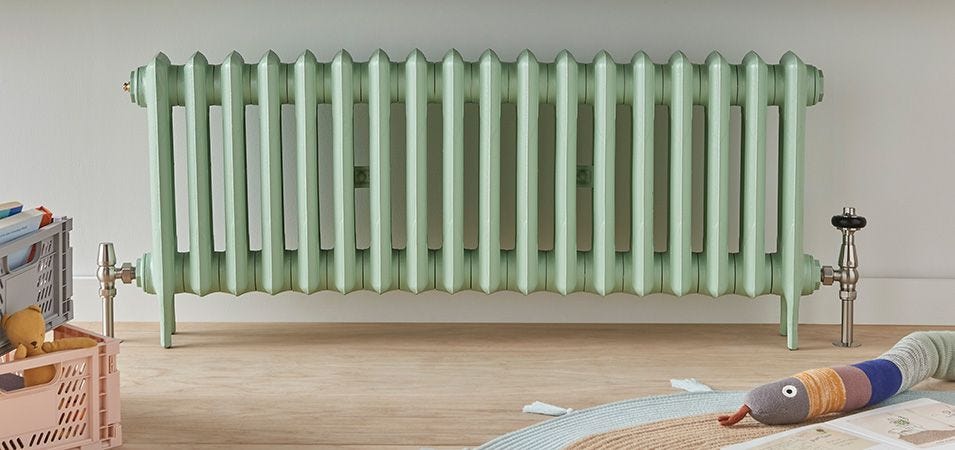How do radiators work? - a complete guide
Heating systems are an integral part of our daily lives, ensuring our homes remain warm and comfortable, especially during the colder months. At the heart of these systems are radiators, often taken for granted but crucial for maintaining a quality environment and standard of living.
It's important for householders to know at least a little bit about how radiators work. A small amount of knowledge can help with:
- Energy Efficiency - Proper understanding and use of controls, such as thermostats and valves, can lead to energy savings and reduced heating costs.
- Comfort - Just knowing how they work can lead to you and your family having a more comfortable living environment.
- Renovations - When renovating or installing a heating system, a knowledge of radiator basics can help you make informed decisions about radiator type, size, and placement.
- Maintenance - Being able to identify common radiator issues, such as airlocks or leaks, allow you to address these issues promptly to prevent more significant problems.
In this article, we take a look into the mechanics behind these amazing household fixtures, exploring the science of heat transfer and the intricate processes that enable radiators to efficiently distribute warmth. Whether you're a homeowner curious about the inner workings of your heating system or an enthusiast looking to expand your knowledge, join us as we delve into the fascinating world of radiator technology.
Table of Contents
- How does a radiator work?
- What are the different types of radiator?
- What size radiator do I need?
- How do you control the heat of a radiator?
- How do electric radiators work?
- How do oil filled radiators work?
- How do electric panel radiators work?
- How do electric infrared radiators work?
- How do electric storage heaters work?
- How do electric towel radiators work?
- How do dual fuel radiators work?
- How do radiator valves work?
How does a radiator work?
A radiator is a device that uses hot water to heat a room as part of a central heating system. This system consists of a boiler that heats water and distributes it throughout the home via pipes. The hot water flows through the radiator, gradually raising its temperature. The essential role of the radiator is to transfer this heat to the surrounding air, thus warming up the room.
Hot water radiators operate on the principle of convection, a process that moves heat from a warmer area to a cooler one. In the context of a radiator, the warmer area is the hot water circulating inside the radiator, while the cooler area is the air encompassing the radiator.
As the hot water flows through the radiator, it warms the metal structure of the radiator itself. Subsequently, the heated metal elevates the temperature of the air nearby. Hot air, being lighter, rises while cooler air enters to take its place, creating a continuous cycle of ascending and descending air. This process, known as convection, effectively circulates the heat throughout the room, keeping it comfortably warm.
Radiator and heating authority, Julie Boyle, breaks down how a radiator works with a really simple analogy:
"To make the functioning of a radiator easy to understand, imagine your central heating system as a giant water kettle. The boiler is the kettle, and the pipes are the spout. When you turn on your central heating, the boiler heats up the water inside it. The hot water then flows through the pipes and into the radiators in each room.
The radiators are like little kettles in each room. They have hot water flowing through them, which heats them up. The heat from the radiators then warms the air around them. The hot air rises, and cooler air comes in to replace it. This creates a cycle of rising and falling air, which circulates the heat around the room."
What are the different types of radiator?
There are a wide variety of different types of radiator that you can get for your central heating system. They are all designed to heat up your home in the same way, but they can vary in style and finish, depending on your personal taste and interior design preferences. You can view all of the different radiator designs on our website, but some of the most common types are listed below.
- Panel radiators are the most common types of radiator in the UK. They are designed with one or two big panels that make up the main body of the radiator. Inbetween or behind the panels are often zig-zag convector fins, which help to increase the surface area of the radiator and emit more heat into the room.
- Cast iron radiators are big, chunky radiators that you might have traditionally seen in old schools, hospitals or period properties. They are very heavy and often come with intricate and ornate designs. Cast iron radiators have made a big comeback in the last couple of decades due to their stylish appearance, suitability for older properties and our general love of all things Georgian and Victorian.
- Column radiators are made of a series of vertical columns that are connected together. They are known for their elegant design and high heat output. They have a similarity to cast iron radiators but are much lighter in weight and plainer in design, making them suitable for all sorts of properties. Column radiators have become a popular choice for those who want something different to the common panel radiators, but not as flashy as an ornate cast iron radiator.
- Towel radiators are also known as heated towel rails, and are typically found in bathrooms. They usually have a ladder-style design with bars that fill with hot water. They are really suitable for warming up and drying wet towels. Towel radiators used to be only found in high-end hotels, but are now commonplace in bathrooms in all types of property
What size radiator do I need?
It's important to get the right size radiator for your room. If you get one that's too small, you'll struggle to heat the room adequately. If you install a radiator that's too large, then you'll probably overheat and have unnecessarily high gas bills. So what can you do?
To determine the size radiator you need for your room, you can use a heating calculator. A heating calculator is a tool that takes into account a number of factors, including:
- the dimensions of your room
- what's above and below your room
- the number and type of windows in your room
- the number of outside walls in your room
- the insulation level of your home
The heating calcutor takes into account all the details you enter and will provide you a heat output figure in British Thermal Units (BTUs). BTUs are commonly used to measure the heat output of appliances and heating systems. When you're looking on our website for a radiator that you think would look good in your home, look at the BTU figure that is provided next to each radiator and compare it with the heating calculator result.
As long as the two figures are roughly the same, you can be quite sure you are getting the right size radiator for your home. Of course, if you are unsure then it's always best to conult a professional heating engineer.
How do you control the heat of a radiator?
There are several different ways that you can control the temperature of a radiator.
- Manual thermostatic radiator valves (TRVs) - These valves are typically located on the side of the radiator and have a numbered dial that allows you to set the desired temperature. The TRV works by sensing the temperature of the air around the radiator and adjusting the flow of hot water accordingly.
- Programmable thermostatic radiator valves (PTRVs) - PTRVs are similar to manual TRVs, but they allow you to program different temperature settings for different times of the day. This can be useful for saving energy, as you can set the radiators to be cooler at times when you are not using the room or when you are asleep.
- Smart thermostatic radiator valves (STRVs) - STRVs are the most advanced type of radiator valve. They can be connected to a smartphone app or home automation system, which allows you to control them remotely. This gives you even more flexibility in how you heat your home. For example, you can turn on the radiators in your bedroom before you get home from work, so that the room is warm when you get in.


How do electric radiators work?
Heating expert, Nicholas Auckland, explains how electric radiators are different from conventional hot water radiators.
"Electric radiators are connected to the mains electricity supply within your home. Every type of electric heater contains an element that converts electricity into heat, which is then emitted into the room. This method of heating differs from a standard central heating system, which relies on a network of pipes to transfer hot water from a gas-powered boiler into the radiators around your home.
In the event that it's not possible for you to have a gas-fired boiler heating system in your home, then electric radiators are an excellent alternative. Modern electric rads are economical and cost-effective and very easy for a professional electrician to install. If you already have central heating but don't want the cost and inconvenience of adding pipework to a new room, such as a conservatory, converted attic or office, then it definitely makes sense to install an electric radiator."
How do oil filled radiators work?
Oil-filled radiators are electric heaters that provide warmth through convection and radiation. Inside the radiator, a series of metal fins are filled with a specially formulated heat-transfer oil. When the radiator is turned on, the electric heating element at the base of the unit warms up the oil. As the oil heats up, it begins to circulate through the radiator, transferring heat to the metal fins.
The heated metal fins then radiate warmth into the room, while the natural convection process allows cooler air to be drawn in from the bottom of the radiator, heated as it passes through the fins, and then released as warm air from the top. This continuous cycle of heating, convection, and radiation creates a steady flow of heat that warms the room efficiently.
The heat transfer oil used in this type of radiator is typically a specialised mineral oil or diathermic fluid. This oil has excellent heat retention properties, allowing it to absorb and store heat efficiently. The specific formulation of the oil is designed to withstand high temperatures without breaking down or deteriorating over time. As the electric heating element heats the oil inside the radiator, the oil circulates through the metal fins, transferring heat to them. This heat is then radiated into the surrounding air, warming up the room.
The use of heat transfer oil is integral to the radiator's functioning, as it enables the rad to maintain a consistent and prolonged heat output even after the heating element has been turned off. The oil's ability to retain heat makes oil-filled radiators energy-efficient and provides a comfortable and steady heat source.
The benefits of oil-filled radiators
- Localised heating - Oil-filled heaters are ideal for targeting specific areas that need extra warmth. This is useful for supplementing heating in drafty spots or rooms that are not adequately reached by the central heating system.
- Quick heat - Oil-filled heaters provide immediate warmth upon turning them on, making them useful for quick heat boosts in smaller spaces.
- Short-term cost savings - Using an oil-filled heater to warm a single room instead of the entire house can save on energy costs, especially if you only need to heat one area. Installing oil-filled heaters into a home also has a much lower upfront cost than a full, hot water central heating system.
- Portability - Many oil-filled heaters are portable and can be easily moved from room to room, allowing you to focus heating where it's needed most.
- Flexibility - You can adjust the heat output of oil-filled heaters independently, which is particularly useful for creating personalized comfort zones.
- No Installation Required - Portable oil-filled heaters don't require installation or connection to a central system, making them convenient for renters or temporary heating needs.
How do electric panel radiators work?
A very common type of electric radiator, these heaters contain an electric element and tend to be made of a material that is a good conductor of heat. The electric element transforms the electricity into heat which is then 'convected' around the room.
Electric panel radiators usually have a very thin profile, making them perfect for wall-mounting and keeping them out of the way. They're very good at heating up quickly and usually contain a thermostat and a timer to easily get heat exactly when you need it.
How do electric infrared radiators work?
When you look at a radiator, you’re not actually looking at a heater which radiates heat around a room. You’re looking at a heater which relies on a small degree of thermal radiation in the radiator to convect heat around a room. This is the basic principle of using a radiator in the home.
Infrared radiators work by emitting infrared radiation, which is a form of electromagnetic energy that heats objects and surfaces directly rather than heating the surrounding air, as with standard electric radiators. The heat produced is primarily in the form of infrared waves, which are absorbed by objects and surfaces in the room, raising their temperature. As these objects heat up, they, in turn, emit heat through conduction and convection, warming the surrounding air and creating a comfortable indoor environment.
Infrared radiators are efficient and provide rapid, targeted heating, making them an energy-efficient choice for many applications. They also look incredibly stylish and can hide in plain sight, often coming with a mirrored finish or looking like a decorative wall hanging.
How do electric storage heaters work?
Storage heaters were once a very popular way of heating homes that did not have conventional hot water central heating systems, whether for financial reasons or because the area was not connected to the mains gas supply.
Inside storage heaters contain rows of ceramic bricks that would get store up thermal energy at night, when electricty is cheaper, and then release heat during the day, when electricity is more expensive. Homes with storage heaters tend to be on special electricity tariffs that differentiate between night and day use, in order to maximise the cost benefits of them. In theory this sounds good but in reality, many old storage heaters often provide too much heat in the morning and not enough in the evening, which is usually when you need heat the most.
Storage heaters are now generally considered as old technology and less efficient and less cost effective than modern electric radiators.
How do electric towel radiators work?
An electric heated towel rail is a towel radiator that is connected to and powered by your mains electricity supply. It does not get its heat from connecting to a boiler or pipework and and therefore does not have hot water flowing through it. Instead, every electric towel rail is attached to an electric heat element, of which there are two main types:
- Single Heat Element - This is a non-thermostatic element which keeps the towel rail at a single fixed temperature when it is switched on.
- Variable Heat Element - This is a thermostatic element which allows the user to change the temperature of the towel rail when it is switched on.
The heating element contains a filament, which looks like a long, thin, metal rod that sticks into the heated towel rail. When the towel rail is switched on at the mains, the filament gets hot and heats up the water-based solution contained inside the body of the towel rail. The hot fluid flows around the towel rail and heat is emitted from the bars.
Unlike a conventional hot water central heating system where a constant supply of water flows in and out of a radiator or towel rail, the fluid is sealed inside the towel rail and is simply reused and reheated each time the rail is switched on. Many electric elements also come with smart functionality, whereby you can connect them to WiFi and control them via an app on your phone or tablet.
It's important to note that most modern electric heated towel rails come with a safety cut out, so that power will be switched off to stop the electric element from getting too hot and burning out. This makes them a really safe way of heating your towels.
The benefits of electric towel radiators
- Easy installation - Electric towel rails are easiy to install because they don't require plumbing connections. You can simply plug them into an electrical outlet, making them suitable for DIY installation.
- Independent heating - They can operate independently of your central heating system. This means you can use them year-round, even during the summer when your central heating may be off.
- Rapid heating - Electric towel radiators heat up quickly, providing warm, dry towels on demand. You don't need to wait for your central heating system to warm them.
- Heating controls - Many electric towel rails come with timers and thermostats, allowing you to set heating schedules and control the temperature.
How do dual fuel radiators work?
Radiator and central heating professional, Nicholas Auckland, explains the basics of dual fuel radiators in simple terms:
"A dual fuel radiator is a type of heated towel rail or radiator that offers the flexibility to be heated either by the hot water central heating system or through electricity, typically via a heating element. They're most commonly used in bathrooms and kitchens, where the option to have warm towels or a heated room during different times of year is really advantageous. These types of radiator offer a practical solution for those seeking heating flexibility while maintaining energy efficiency."
The benefits of dual fuel radiators
- Versatility - They provide versatility in how you heat them. You can choose to use your central heating system, usually in the colder months, and switch to electricity during warmer periods when you don't want to heat the entire house.
- Year-round use - With dual fuel heating capability, you can keep your towels warm and dry even when your central heating system is turned off during the summer months. This is particularly useful for bathrooms, kitchens or utility rooms where warm towels are still desired.
- Quick heating - Electric heating elements in dual fuel radiators heat up quickly, providing warmth and dry towels on demand. This can be convenient when you need rapid heating without waiting for the central heating to kick in.
- Energy efficiency - Dual fuel rads allow you to choose the most energy-efficient heating source for your current needs. You can reduce energy consumption and heating costs by using electricity when central heating isn't required.
How do radiator valves work?


The main purpose of a radiator valve in a central heating system is to control the flow of hot water into a radiator, which in turn controls the amount of heat that is emitted from the radiator into the room. Radiator valves can be either manual or thermostatic, with the latter allowing for greater temperature control and energy efficiency.
In a typical central heating system, hot water is circulated through a network of pipes and radiators to provide warmth to different areas of a building. Radiator valves allow the user to adjust the temperature of each individual radiator, which can help to save energy and reduce heating costs. For example, if a room is not being used, the radiator valve can be closed to prevent heat from being wasted.
Additionally, thermostatic radiator valves (TRVs) can automatically adjust the flow of hot water to maintain a desired temperature, which can help to ensure that each room is heated to the appropriate level without overheating.
What's the difference between manual and thermostatic radiator valves?
A manual radiator valve and a thermostatic radiator valve (TRV) are two types of radiator valves that control the flow of hot water into a radiator, but they work in different ways.
A manual radiator valve is a simple on/off valve that you manually adjust to control the temperature of the room. It has two settings, fully open and fully closed, and does not have a temperature sensor, numbers or any automatic controls. This means that you need to adjust the valve manually to maintain a comfortable temperature in the room, which can be inconvenient and lead to energy wastage if you forget to turn it off.
On the other hand, a thermostatic radiator valve (TRV) is a type of valve that automatically regulates the flow of hot water into the radiator based on the temperature of the room. It has a built-in temperature sensor that detects the temperature in the room and adjusts the flow of hot water accordingly to maintain a constant temperature. This means that the TRV can help to reduce energy wastage and save you money on your heating bills by only using as much energy as is needed to maintain the desired temperature.
While a manual radiator valve requires manual adjustments to control the temperature, a thermostatic radiator valve can automatically regulate the temperature of the room, making it a more convenient and energy-efficient option.
You can read more about TRVs in our articles:
What are the different types of radiator valve?
Different types of radiator valves are available, and your choice depends on your radiator's inlets/outlets and pipe locations. Here's an overview of the valve types:
- Angled valves - These have an L-shaped design with an inlet at the bottom and an outlet at the side. They are ideal when the pipes come out of the wall at an angle, requiring a right-angle connection to the radiator.
- Corner valves - Similar to angled valves but with an additional bend, they suit pipes emerging at a 90-degree angle from the wall, necessitating a right-angle connection to the radiator.
- Straight valves - These valves have a straight-through setup, featuring an inlet at the bottom and an outlet at the top or side. They are suitable when pipes come out directly below or above the radiator, requiring a straight-line connection.
- H-block valves - Also known as twin valves, these are used when the pipes emerge close together on one side of the radiator. They have a cross-shaped configuration with two inlets and two outlets, perfect for connecting radiators to pipes in compact spaces.









































